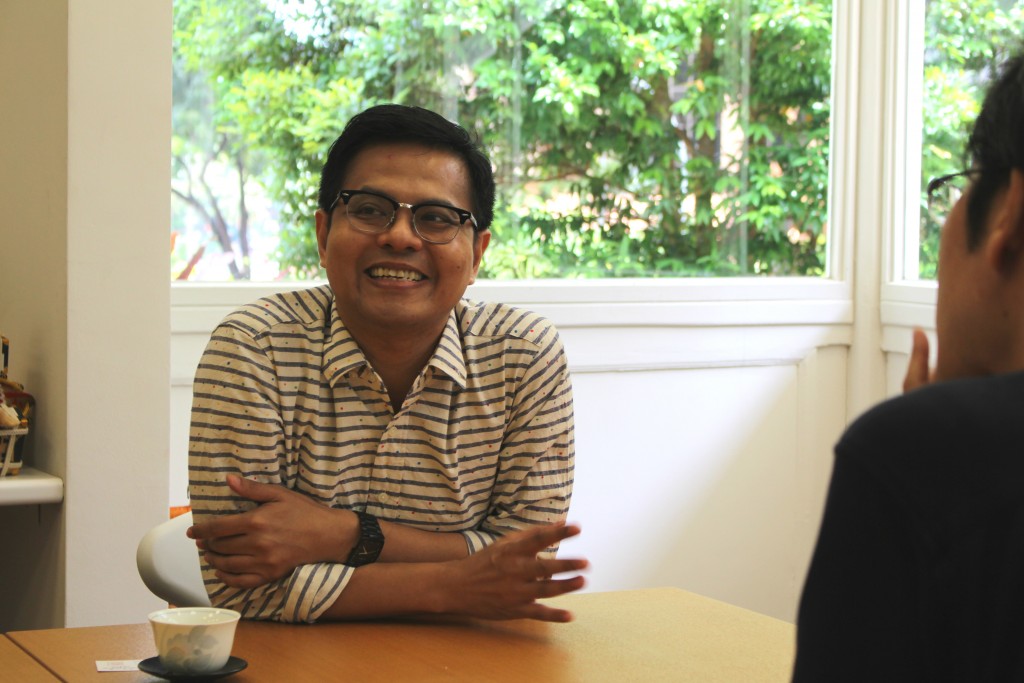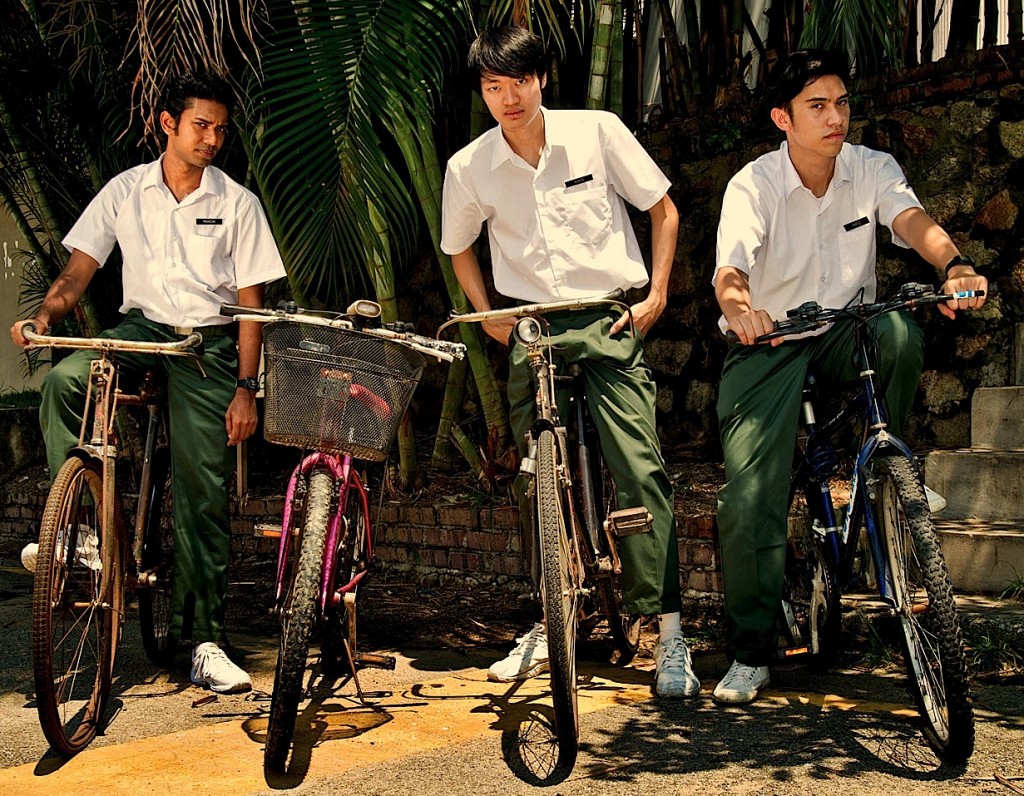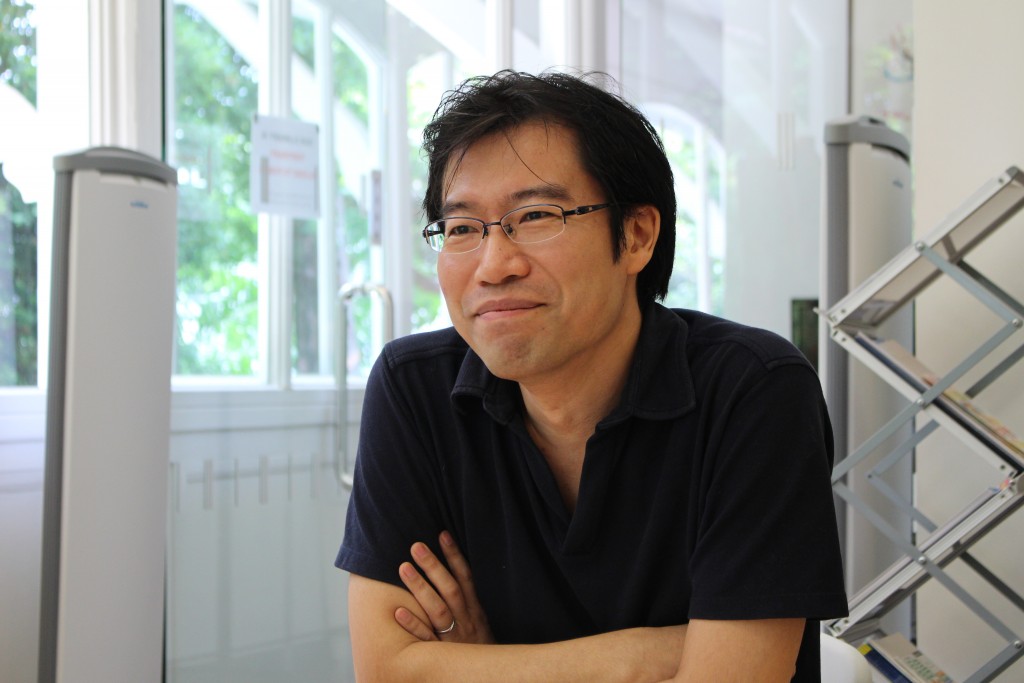Bringing Works to Malaysia and "Malay-ness"
―Your relationship with Malaysia is quite long and deep. Causeway, in which you worked with Teater Ekamatra of Singapore and The Actors Studio in Kuala Lumpur in 2002, was the first production I saw. It was a collection of short pieces in Malay.

Alfian: I have to rewind and think. Causeway was a collaborative piece. In the process, I realized that our imaginings of each other as a country were not quite even. It turned out that we, from Teater Ekamatra, were to work with actors from Kuala Lumpur but some of them had not even visited Singapore. They just imagined Singapore to be a shopping destination. If we had a workshop with actors from the southern state of Johor, which is directly connected to Singapore with two bridges, things might have been quite different. If there were people from Penang, which is also an island and once was the British Straits Settlement along with Malacca and Singapore, it would have been different too. But it was quite an interesting experience to observe the imbalance. Singaporeans, especially Malay Singaporeans, had a sense that a lot of Malay popular culture came from Malaysia, but this cultural flow did not occur in the opposite direction.
―And you continued to work with Malaysian artists. I understand Nadirah, which was staged in Kuala Lumpur in 2012 by Malaysia's Instant Café Theatre Company (ICT), was a remarkable success. I heard that you made a slight change to the script from the original version that was staged in Singapore.

Nadirah (c)Teater Ekamatra
Alfian: Yes, that's right. Initially, there was a character—a very sassy and independent-minded Malay girl who was the protagonist's best friend and both of them were undergraduates of the National University of Singapore. I changed this character into a Malaysian, specifically an exchange student from Malaysia, but kept the rest of the lines in the script unchanged. By doing this, I wanted her to manifest some of the racial politics in Malaysia within the play. I also wanted her to have these wounds that Singaporean Malay girls are free of. For example, as an adolescent Muslim woman, she would be under a lot more pressure to wear the tudung (scarf) on a Malaysian campus than a Singaporean one. This is because there would be a Malay-Muslim majority in that Malaysian campus that is more likely to police her behavior and even dressing.
―Was this change to make the play more relevant to the Malaysian audience?
Alfian: Yes. I always feel that having certain bridges for the audience's identification in the work is useful when we tour to other countries. Another reason for the amendment was that we cast Malaysian actors. It was important for me to let them have a sense of investment in their roles. It was not to say that Malaysia and Singapore are so different.

Parah (c)Teater Ekamatra
―How do you feel when you stage your work—especially the works in Malay—in Malaysia?
Alfian: I have brought a couple of my Malay plays to Malaysia. In the early 2000s, I did a double bill. One of them was called Madu II. Madu is "honey" in Malay but it also means having a second or third wife, which is legal for Muslims. It was a play on polygamy, a revisionist take on the legendary Malay actor P. Ramlee's film called Madu Tiga. In the film, whose title means "three honeys", Ramlee had three wives but hid them from each other. My Madu II was about two women waiting for their husband to come home. It was a feminist play told from the women's perspectives. Another play called Anak Bulan di Kampung Wa'Hassan, which means "the new moon at the village of Wa'Hassan," was staged in Malaysia. This monodrama, which tells the story of the last Malay kampung (village) in Singapore falling victim to the country's efforts toward modernization, was first staged in Kuala Lumpur and then toured to six rural towns all over the Peninsular Malaysia.
I always wanted to bring my Malay plays to Malaysia. It is not just about getting anew audience. Malay is the national language of Malaysia and I was hopeful that these plays were able to transcend ethnicities there. Actually a lot of non-Malay audiences came to watch our plays in Malaysia. I found that kind of mixed audience a lot more interesting. We also have a mixed audience in Singapore, but that is only because of the English surtitles.
―I think the proximity between Singapore and Malaysia—not only in geographical terms but also the socio-political conditions—makes the collaboration between these two countries unique. But that should be quite challenging for you too, I imagine.
Alfian: The ICT, which produced Nadirah, staged another of my Malay plays titled Parah (Wounded).

Parah (c)Instant Cafe Theatre Company
It was set in Malaysia, and the story was based on the so-called "Interlok" controversy that became a topic of heated discussion around 2011. The Interlock controversy sprung when the Malaysian government selected local author Abdullah Hussein's Interlok, a novel written in the mid-1960s, as a school textbook of Malay literature. That novel introduced the Indians to the Malays as the "pariah" caste, which was considered derogatory and demeaning by the local Indian community. Many NGOs and activists openly questioned the decision to use such a controversial book in schools and let students of all races be exposed to this text.
It was not simply about the considerations for the minorities. This controversy fundamentally questioned the politics of multiculturalism in Malaysia and highlighted the complexity of the racial and cultural issues rooted in the society. Bringing a play that dealt with such a topic to Malaysia, I, as a playwright from Singapore, had to be very aware that there could be responses like, "Oh, it took a Singaporean outsider to write about our Malaysian condition. Why should we have foreigners tell our stories for us?" But I did not want that. What I really wanted to say was, "but we are really not that different. I am not parachuting in from an alien place trying to figure out what your society is like." I am not a Malaysian per se but I am familiar enough to write about the society as a kind of insider. In fact, all the news and comments on the Interlok controversy which I used as reference as I wrote Parah came from my Facebook newsfeed.


―Malays are minorities in Singapore while they are majorities in Malaysia. Does it affect your writing a lot?
Alfian: It is difficult to answer. Yes, Malay language is hegemonic in Malaysia. We acknowledge that and I know I need to be conscious of it. I need to be self-reflexive: if I use this hegemonic language in Malaysia would I also reproduce other kinds of hegemony? At the same time, however, my plays can be counter-hegemonic. This is because they are mostly written in the everyday vernacular whereas a lot of plays that are accorded high status in Malaysia tend to be written in more literary Malay.
I am aware that people would say, "Hey, this Malay writer is from Singapore. He campur-campurkan (mixes up) Malay with English." I would insist that this is precisely the Malay language spoken in Singapore. I think it still is a tussle in Malay theater that theater is an extension of literary arts. In Malaysia, we have bureaucratized literature represented by, for example, Sasterawan Negara (National Laureate in literature). In that context, the purity of the language suddenly becomes so precious and there is so much fear about the Anglicization of the language.
―You talked about the segmentation of theater in Singapore by language. But that is also the case in Malaysia, isn't it? The ICT is considered an English-language theater company.
Alfian: That is correct, but I think the ICT has been evolving too. Their signature performances in the early years were sketch shows and parodies—political satires on topical issues—which attracted middle-class liberal and expatriate audience. But ever since the company's director, Jo Kukathas, started working with artists from various backgrounds—such as interdisciplinary artist Shanon Shah who is a singer-songwriter, playwright, and activist, and directors from other language streams like Nam Ron and Loh Kok Man to name a few—their audience has shifted, and the ICT's works have gained a quite different and much wider appeal. This hybridity is precisely the reason why I worked with them and did not choose to work with the so-called Malay theater companies in Malaysia when I did Nadirah.
For me, it is very important not to get trapped by the current segmentation. I did not want to perform to the Malay-only audience at Stor Theatre at Dewan Bahasa dan Pustaka, which was considered the epicenter of Malay theatre in Kuala Lumpur. So, working with the ICT made more sense to me, and my works were exposed to a more mixed group of audiences.

Intercultural Collaborations and their Platforms
―It seems there is a pretty good foundation for intercultural collaborations beyond the border.
Alfian: Yes, there are more opportunities for collaborations and it is very exciting for me. Maybe I have not been in the loop of networking among Southeast Asian artists, but I find a platform like TPAM quite useful. People could meet at the official group meetings and interviews, as well as in casual settings like late night meetings at a bar. I had occasions to meet some of the artists from the region before and even already knew some of whom I met in Yokohama, but an on-going platform that allows us to gather and meet each other would provide different kinds of encounters.
In Yokohama, we could unwind and discuss things which we had never talked about before. One night, we tried to figure out what "Southeast Asia" is. Why shouldn't Sri Lanka be a part of Southeast Asia? Why is Myanmar a part of Southeast Asia and not South Asia? Why isn't Vietnam a part of Northeast Asia, considering its Sinic and Confucian culture? Who defined us in this way? Is it the CIA? What do we have in common?
This TPAM experience also made me think, "there are a lot of exchange programs in dance which is great. But it could be a bit of easy way out because dance can sidestep the questions of language of this region. If the Southeast Asian artists collaborate in a project, what should the common working language be? Is English going to be the default language? I know that at the ASEAN meeting, it was proposed to use Bahasa Indonesia (Indonesian) as a working language because of the size of the population using it in the region. But can the population size be the only determinant?" I think these things need to be examined.
―How about the Japanese artists?

Alfian: I watched several performances by young artists during my stay. I was really impressed by a documentary piece called Kagerou: Study of Translating Performance by the Hamanaka Company. There was a voice of a woman from Fukushima who lost her husband in the tsunami in 2011. I was listening to the simultaneous translation of the woman's interview. It was really moving because the translation was quite dispassionate, and the translator was very conscious not to act out what the woman was saying.
There were constant gaps in this performance, which were interesting to me: the gap between the Japanese–English translation and the one between the experience of the tragedy and its articulation on stage. What could have been lost in translation? It was a very simple piece yet very moving. There was an idea of respectful distance you need to make, avoiding voyeurism. I really liked the piece.
―Are you interested in working on Japan-related themes?
Alfian: Actually I am researching a lot on the period of Japanese occupation of Singapore right now. I have been reading about Shinozaki Mamoru, a diplomat stationed in Singapore during the Japanese military administration, who is dubbed as "Japan's Schindler." He issued a number of credentials for proving the holder had not been involved in any anti-Japanese activities to prevent them from being inspected by the Japanese Kempeitai (Military Police) soldiers.
I have examined the interviews and records on the occupation at the National Archives of Singapore, and found a lot of people mentioned him. But I noticed that there was also a fear in overtly stating how they had been saved by this Japanese man. People seemed to avoid it. Was it survivor's guilt? A sense like, "I don't want to talk about this man who saved me when many other people were murdered"? Or was it fear? Could they have thought, "he saved me and therefore I might be seen as a collaborator of the Japanese army. Would it get me in trouble?" Shinozaki is not celebrated in Singapore. I suppose not in Japan either. I wonder whether this basic act of human kindness has become entangled in the politics of that period. Or even today, these kinds of fears might emerge from the politics of war guilt. I want to explore this further.
―There is so much to unfold in the history between Japan and Singapore, but at the same time, there have always been tension when theater tried to challenge such issues. I am really looking forward to this project and seeing your own approach to the complexity of the history.

[February 22, 2016 at Japan Creative Centre, Singapore]
Interview and text: Ken Takiguchi
Takiguchi is a research fellow at the Theatre Studies Programme, Department of English Language and Literature, National University of Singapore, specialising in theatre translations, intercultural theatre and cultural policy in East and Southeast Asia.
Ken also works in theatre as a dramaturg, translator and producer. He started his practice when he was the Assistant Director of the Japan Foundation Kuala Lumpur. He has actively participated in numerous intercultural productions. He participated in W!LD RICE's HOTEL as a Japanese translator.






